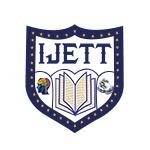Performance Assessment of Equal Gain Combining Fusion Rule in Cognitive Networks
Performance Assessment of Equal Gain Combining Fusion Rule in Cognitive Networks |
||
 |
 |
|
| © 2022 by IJETT Journal | ||
| Volume-70 Issue-4 |
||
| Year of Publication : 2022 | ||
| Authors : Aparna Singh Kushwah, Vineeta Nigam |
||
| DOI : 10.14445/22315381/IJETT-V70I4P212 | ||
How to Cite?
Aparna Singh Kushwah, Vineeta Nigam, "Performance Assessment of Equal Gain Combining Fusion Rule in Cognitive Networks," International Journal of Engineering Trends and Technology, vol. 70, no. 4, pp. 146-151, 2022. Crossref, https://doi.org/10.14445/22315381/IJETT-V70I4P212
Abstract
Optimal use of spectrum is based on the investigation of the primary signal present in the spectrum. Various methods are discussed in the literature for signal detection. The research presented is about the performance evaluation of the Equal Gain Combining fusion rule in cognitive radio. The analysis of equal gain combining is executed using MATLAB simulations. The energy detector is used for individual sensing at each Cognitive Radio. Computer simulations reveal that Equal Gain Combining shows considerable detections at low SNR levels. As the level of SNR is increases, the detection capability also increases without imposing any burden on the channel regarding channel-state information. Further, the effect of varying the Time-Bandwidth Product and the total cognitive radios participating in the sensing is also analyzed. Results show that the ideal value for the Time-Bandwidth Product (u) is 10. Results reveal that the optimal number of cognitive radios used for combined sensing is 5.
Keywords
Equal Gain Combining, Energy Detection, Probability of false alarm, Time bandwidth product.
Reference
[1] Simon Haykin, Cognitive Radio: Brain-Empowered Wireless Communications, IEEE Journal On Selected Areas In Communications, 23(2) (2005).
[2] D. Taguig, B. Scheers, and V. LeNir, Data Fusion Schemes for Cooperative Spectrum Sensing in Cognitive Radio Networks, Military Communications and Information Systems Conference, (2012).
[3] Tevfik Y¨ucek and H¨useyin Arslan, A Survey of Spectrum Sensing Algorithms for Cognitive Radio Applications, IEEE Communications Surveys & Tutorials, 11(1) (2009).
[4] Pankaj Verma, Brahmjit Singh, On the decision fusion for cooperative spectrum sensing in cognitive radio networks, Wireless Networks, (2016).
[5] Hano Wang, Gosan Noh, Dongkyu Kim, Sungtae Kim and Daesik Hong, Advanced Sensing Techniques of Energy Detection in Cognitive Radios, Journal of Communications and Networks, 12(1) (2010).
[6] Dong-Jun Lee, Adaptive Cooperative Spectrum Sensing using Random Access in Cognitive Radio Networks, IEEE 24th International Symposium on Personal, Indoor and Mobile Radio Communications: MAC and Cross-Layer Design Track, (2013).
[7] J. Tong, M. Jin, Q. Guo and Y. Li, Cooperative Spectrum Sensing: A Blind and Soft Fusion Detector, IEEE Transactions on Wireless Communications, 17(4) (2018) 2726-2737.
[8] G. Sharma, R. Sharma, Performance comparison of hard and soft fusion Techniques for Energy Efficient CSS in Cognitive Radio, International Conference on Advanced Computation and Telecommunication (ICACAT), (2018).
[9] Srinivas Nallagonda, S. Kumar Bandari, Sanjay Dhar Roy and Sumit Kundu, Performance of Cooperative Spectrum Sensing with Soft Data Fusion Schemes in Fading Channels, Annual IEEE India Conference (2013).
[10] Doha Hamza, Sonia Aïssa and Ghassan Aniba, Equal Gain Combining for Cooperative Spectrum Sensing in Cognitive Radio Networks, IEEE Transactions on Wireless Communications, 13(8) (2014).
[11] Sanjeewa P. Herath, Nandana Rajatheva, Analysis of Equal Gain Combining in Energy Detection for Cognitive Radio over Nakagami Channels, (2008).
[12] Goutam Ghosh, Prasun Das and Subhajit Chatterjee, Cognitive Radio and Dynamic Spectrum Access –A Study, International Journal of Next-Generation Networks (IJNGN), 6(1) (2014).
[13] Abdullah Yaqot and Peter Adam Hoeher, Efficient Resource Allocation in Cognitive Networks, IEEE Transactions on Vehicular Technology, 66(7) (2017).
[14] Yan Cai, Yiyang Ni, Jun Zhang, Su Zhao and Hongbo Zhu, Energy efficiency and spectrum efficiency in underlay device-to-device communicationsenabled cellular networks China Communications. (2019).
[15] Ishu Gupta, Ashish Hari and O. P. Sahu, Hardware Implementation of Energy Detection Scheme in Cognitive Radio Networks, International Conference on Computing, Power and Communication Technologies (GUCON) , (2018).
[16] A. S. Tellambura, et al., Energy detection based cooperative spectrum sensing in cognitive radio networks, IEEE Transactions on Wireless Communications, 10(4) (2011) 1232-1241.
[17] Nan Zhao, Fei Richard Yu, Hongjian Sun and Arumugam Nallanathan, Energy-efficient cooperative spectrum sensing schemes for cognitive radio networks, EURASIP Journal on Wireless Communications and Networking 2013, Springer.
[18] Hano Wang, Jason Noh, Dongkyu Kim, Sungtae Kim, Datsik Hong, Advanced Sensing Techniques of Energy Detection in Cognitive Radios, Journal of Communication and Networks, 12(1) (2010).
[19] Omar Altrad and Sami Muhaidat, A new mathematical analysis of the probability of detection in cognitive radio over fading channels, EURASIP Journal on Wireless Communications and Networking, (2013).
[20] Risheek Kumar, Analysis of Spectrum Sensing Techniques in Cognitive Radio, International Journal of Information and Computation Technology. 4(4) (2014) 437-444.
[21] Qin Qin, Zeng Zhimin, Guo Caili, A Study of Data Fusion and Decision Algorithms Cooperative Spectrum Sensing, Sixth International Conference on Fuzzy Systems and Knowledge Discovery, IEEE. (2009).
[22] Nisha Yadav and Suman Rathi, A Comprehensive Study of Spectrum Sensing Techniques in Cognitive Radio, International Journal of Advances in Engineering and Technology, (2011).
[23] Ian F. Akyildiz, Brandon F. Lo and Ravikumar Balakrishnan, Cooperative Spectrum Sensing in Cognitive Radio Networks: A Survey, Physical Communication, ScienceDirect, Elsevier.(2010).
[24] W. Ejaz, N. ul Hasan, S. Lee and H. S. Kim, I3S: Intelligent Spectrum sensing scheme for cognitive radio networks, EURASIP Journal of Wireless Communications and Networking, Springer. (2013).
[25] Bin Shen, Taiping Cui, Kyungsup Kwak, Chengshi Zhao and et al., An Optimal Soft Fusion Scheme for Cooperative Spectrum Sensing in Cognitive Radio Network, IEEE Communications Society, WCNC proceedings. (2009).

